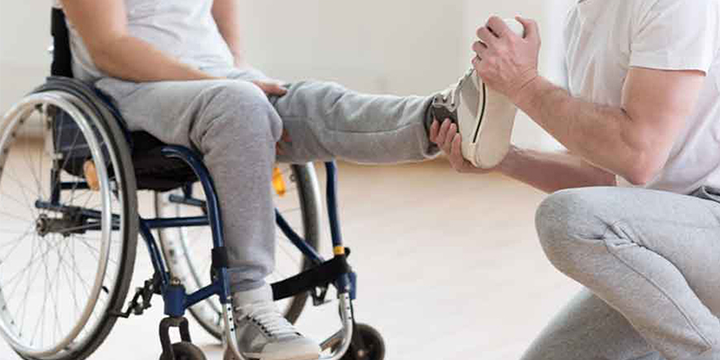
Paralysis
- April 12, 2021
- Posted by Dr. Vaidya Karanvir Singh
- 0 Comment(s)
Paralysis is a loss of strength in and control over a group of muscles in a specific part of the body or loss of muscle function .It can affect any part of your body resulting from diseases of the cerebral vasculature and cerebral contents.
In Ayurveda, Paralysis is correlated Pakshaghata which means “paralysis of half side of the body” where “Paksha” denotes either half side of the body, and disability of body parts and difficulty in movement is known as“Aghata ”.
Table of Contents
Types of Paralysis
- Facial Paralysis– loss of strength and movement of facial muscles.
- Monoplaegia– loss of strength of one limb.
- Hemiplegia– involving one side of the body.
- Paraplegia– Paralysis of both legs.
- Quadriplegia– Paralysis of all four limbs.
Causes
- Cerebro-vascular accidents (Stroke)
- Cerebral hemorrhage
- Subarachnoid hemorrhage
- Cerebral thrombosis
- Internal carotid artery thrombosis or stenosis
- Cerebral embolism
- Venous sinus thrombosis
- Hypertensive encephalopathy
- Cerebral tumors
- Acute encephalitis
- Brain or spinal cord nerve’s impairment
- Multiple sclerosis
- Brain infections and environmental toxins
- Peripheral neuropathy infectious or autoimmune disorders like HIV, spondylitis, Lyme disease, and Guillain-Barre syndrome
- Nervous system disorders like Bell’s palsy and cerebral palsy
- Direct trauma to a nerve due to toxin, poison, and radiation
Risk factors
- Age
- Sex
- Smoking, Alcohol abuse
- Obesity
- Hyperlipidemia
- Hypertension
- Diabetes mellitus
Clinical features
- Changes to the kidneys and gastrointestinal system
- Abnormality in muscles, joints, and bones
- Changes to circulation and respiration
- Spasticity of the limbs
- Clasp-knife type spasticity
- Muscle spasms
- Pressure sores
- Edema
- Blood clots in the lower limbs
- Skin injury
- Mobility of the hands along with finger are more affected than those of the upper arm
- Bacterial infection
- Disruption of the normal functioning of the tissues, glands, and organs
- Constipation
- Loss of control of urination
- Abnormal sweating
- Tongue is projected towards the paralyzed side (in case of facial palsy)
- Unilateral loss of voluntary functions in the affected arm, leg, and the lower portion of the face
- Abnormal breathing or heart rate
- Balance problems
- Difficulty in speaking or swallowing
- Vision difficulty
Management approaches
1. Prevention
- Add black gram, horse gram, onion, garlic, ginger, radish, ash gourd, green gram in regular diet.
- Use fruits like pomegranate, mango, grape, etc.
- Consume low fat and high fiber diet and take Rasayana drugs
- Control diabetes mellitus, heart diseases, and hypertension.
- Take necessary treatment of hypertension (if any)
- Control cholesterol level and weight
- Practice regular exercises
- Regulated consumption of processed food, packed food, refined sugars, astringent or salty, oily food and incompatible diet, Bengal gram, peas, and barley
- Avoid Excess physical exercises, extreme starvation, suppressing natural urges like thirst, hunger, and urination.
- Avoid alcohol consumption, smoking
- Avoid discontinuation of any daily medication without medical advice
2. Medical management
Line of treatment (Charaka Chikitsa sthana-28/100)
Nidana parivarjana (avoid causative factors)
Handling of treatable risk factors (diseases) like high blood pressure, encephalitis (Acute inflammation of brain), cardiovascular diseases and avoid trauma.
Samshodhana chikitsa
Snehana (Oleation)
- Prabhanjana vimardana taila
- Kshirabala taila
- Mahamsha taila
- Bala taila
- Sahacharadi taila
- Dhanvantara taila
- Karpasasthyadi taila
Svedana (Medicated fomentation)
- Shashtika shali pinda sveda (with shali rice, Bala Mula, Ashvagandha Mula,etc. and milk) and Patra Potli pind sweda for 14 days
- Sarvanga sveda(steaming with decoction) for 14 days.
Virechana (Purgation)
Decoction of the mentioned herbs is helpful
(a) Draksha (Vitis vinifera) – 10 gm,
or
(b)Aragvadha Phala Majja(Cassia fistula Fruit pulp) – 10gm
or
(c) Haritaki (Decoction or powder form) – 10 gm
or
(d) Katuki – 5 gm along with Eranda tail – 10ml or
only Eranda tail (Riccinus Communis oil) -20 ml with half glass of warm milk at night
Vasti (medicated enema)
Matra Basti with Narayana taila 50 ml daily for 14 days
- Kashaya vasti for 15 days with Eranda Mula kvatha – 480 ml, Taila – 240 ml, Honey-240ml, Kalka – 30 gm, Saindhava lavana – 15 gm
- Kshira vasti – 400 – 500 ml for 14 days.
Nasya
Nasya with Shadbindu taila or Anu taila 4-4 drops in both nostrils for 14 days
Shirovasti
Medicated oils like Ksheera Bala taila or Chandana Balaadi taila or maashadi taila can be used to perform Shirovasti regularly for 50 minutes for 14 days
Shirodhara
Medicated oils such as Narayana taila / Ksheera Bala taila / Chandana Bala lakshadi taila / decoctions etc. can be used to perform Shirodhara daily 40 minutes for 15 days
Churna Pinda Sweda
In the disorders of soft tissues like muscles, ligaments ,tendons etc. churna pinda sweda is very beneficial. Fine or coarse powder of ayurvedic herbs is known as churna. Pinda means a bolus and Sweda means fomentation. Sudation given by using a potli which is prepared from cotton cloth by the combination of various herbal powders is called Churna pinda sweda.
3. Yogic practices
The following yogic practices are very useful in Hemiplegia; but, these should be practiced only under the guidance of a qualified Yoga teacher.
- Practice of Pranayama (Nadi shodhana, Bhramari,udgeet, and meditation along with the practice of Yama and Niyama.
- Deep relaxation technique such as yoga Nidra
- Asanas to be corrected for postural imbalances

Dr. Vaidya Karanvir Singh is the younger Vaidya in Chandigarh Ayurved & Panchakarma Centre. He is the fourth generation in his family who is practicing as a general consultant in Ayurved & Panchakarma treatment at Chandigarh. In his practice, he had treated more than 1 Lakh Plus patients worldwide.

